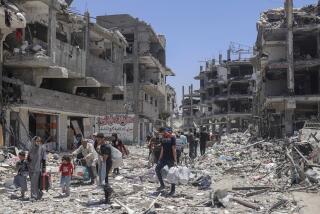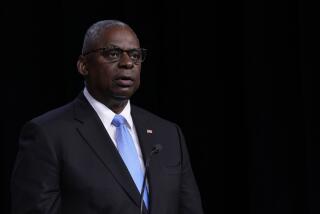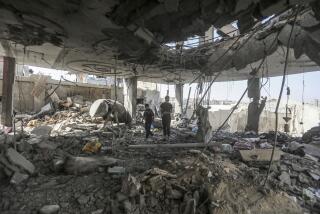Iraqi Troop Shifts May Signal Fear of Attack : Military: Forces gather along border and at Kuwaiti coastline. U.S. begins to consider offensive strategies.
- Share via
WASHINGTON — In an indication that Iraqi President Saddam Hussein may be bracing for an imminent American military strike, his army has shifted its most elite forces from Kuwait back into Iraq while shoring up other defenses along the Kuwaiti coastline, according to U.S. intelligence analysts.
The move comes as American military planners begin to turn their attention to possible offensive strategies, noting that the United States is nearing the point at which it can mount a multipronged offensive against Hussein’s military establishment.
The transfer of Iraq’s battle-hardened Republican Guard units to positions along the Iraqi border marks a major departure from a previous posture in which the elite forces were concentrated in Kuwait.
Bush Administration sources told The Times that the shift of the Republican Guards signaled new concern in Baghdad about a possible all-out American attack aimed at territory in Iraq, as well as in occupied Kuwait.
Meanwhile, Defense Secretary Dick Cheney acknowledged for the first time that the United States is “clearly in the position today to defend” Saudi Arabia against a possible Iraqi attack. Military commanders in the region hinted that U.S. forces were building up offensive capabilities to back up bellicose Administration rhetoric.
Within the Pentagon, a senior U.S. military official said talk had abruptly shifted from how to get troops to the Middle East to how to use the substantial air, land and sea forces now arrayed there to crush the Iraqi military and drive Hussein from power.
Such offensive planning remains only a contingency, and knowledgeable sources cautioned that there still is considerable opposition.
Some U.S. officials believe the estimated 35,000 U.S. troops deployed on the ground so far are not sufficient to mount an offensive operation against Iraq’s 1-million-man army. And they contend that the Pentagon’s faith in high-technology air and sea power is misplaced.
But as concern mounts about the fate of Americans trapped in the region, President Bush and his senior advisers could be forced to decide whether the United States should take the risk of striking quickly or whether it is prepared to endure a potentially long and painful stalemate, compounded by a hostage crisis of unprecedented dimensions.
Despite initial declarations that the mission of U.S. troops was to defend Saudi Arabia, Bush in recent days has left no doubt that more aggressive military options remain on the table. “Hard choices remain,” he said Monday, adding: “Just watch and see.”
The tougher talk from the President is backed up in the Middle East by new indications that American troops and materiel, being moved into forward positions in the Saudi desert and surrounding waters, are well-equipped for offensive purposes.
These include the 7th Marine Expeditionary Brigade, equipped with tanks, heavy artillery and Cobra attack helicopters, and attack-oriented naval forces aboard aircraft carriers armed with A-6 attack bombers, F-18s and EA-6B radar-jamming planes. U.S. warships carrying cruise missiles ring Iraq, while B-52 and FB-111 bombers based in Turkey and the Indian Ocean are within easy reach of the nation’s interior.
To be sure, any decision to take quick offensive action would require advocates within the Administration to overcome deep institutional caution from the military, which is likely to resist any call to action until all of its forces are in place.
“There are not enough (troops) there,” a senior Army officer said. “Every day our capability grows. We’re not incapable. But we’re not ready yet.”
And military analysts emphasized that the need for domestic political support would require that any American attack come in retaliation to a further hostile move by Iraq.
“We don’t fight wars in cold blood,” said retired Army Col. Harry Summers Jr., a noted historian and military expert. “The American public is not going to permit the President to go on the offensive without significant provocation.”
But with the Vietnam War fresh in the military memory, Administration officials and outside experts also said that if conflict seems inevitable, the Pentagon will reject gradual escalation in favor of an all-out attack.
December’s invasion of Panama indicated the current Pentagon preference for a quick strike using overwhelming power as the most effective and least costly means of achieving a military objective.
Such a course is viewed as attractive by many military analysts, who argue that Bush faces only a limited window of opportunity during which he might deliver a punishing blow to Iraq while retaining some hope of saving the majority of the 2,500 Americans currently in Kuwait.
“If (Hussein) does with the hostages what he says he’s going to do, that is not a trivial complicating factor,” said Thomas L. McNaugher of the Brookings Institution, an expert on Middle East military affairs.
“If (Hussein) distributes those hostages around the country, he is forcing the President into two modes: either a quick preemptive strike now, or rely on the sanctions to force the Iraqis out of Kuwait.”
According to this view, time may not be on America’s side. Each passing day allows the Iraqi leader to disperse his forces and weapons, fortify defensive positions, plan terrorist actions and place U.S. hostages at critical military targets, making the Pentagon planners’ task vastly more difficult.
In his remarks while winding up a tour of the region Tuesday, Cheney made clear that he is now satisfied that the military force the United States has assembled in the region--35,000 ground troops, 500 fighter and attack aircraft and 70 warships--is sufficient to protect Saudi Arabia and the friendly gulf states from Iraqi attack.
But others note that the force is capable of a wide range of offensive operations that could accomplish Washington’s central, but unstated, goal of toppling Hussein and destroying his army.
“It’s taken as a given here--Saddam has to go, and so does his army. If the (Iraqi) military doesn’t remove Saddam, we will,” said a senior Pentagon analyst.
This official said the chief concern was “how to employ our forces, not just deploy them.” He said the Pentagon was on a virtual war footing, with operations centers staffed round the clock and conference tables stacked high with top-secret target folders.
A conventional hostage rescue operation is regarded as impossible because of the sheer number of Westerners held in Kuwait and Iraq. Apart from negotiation, the only hope for getting them out may be to use sufficient force to persuade the Iraqis to free them, terrorism consultant Neil C. Livingstone said.
Such a strategy would involve an overwhelming air, sea and missile bombardment of dozens of Iraqi targets, from the presidential palace in Baghdad to Iraq’s chemical and nuclear weapons plants, a strategy characterized by former Secretary of State Henry A. Kissinger as “the surgical and progressive destruction of Iraq’s military assets.”
Bombers, cruise missiles, naval guns and rockets would be unleashed on Iraqi airfields, ports, pipelines, weapons depots, missile sites, armaments factories, water plants--the whole war-making infrastructure of the highly militarized nation.
Experts acknowledged that any U.S. hostages placed at those facilities would be almost certain to be killed in what Livingstone called “a cost we’re going to have to bear.”
The question of hostages “is a hard one, but I wouldn’t assume that it will paralyze us or make us change our direction,” said a senior official involved in managing the crisis. “He (Hussein) runs a very high risk if he starts doing something with the hostages.”
Under this scenario, as U.S. warplanes were pounding Iraqi installations, the Army troops now deployed in Saudi Arabia would launch an attack on Iraqi forces now in Kuwait, and U.S. Marines would stage a huge amphibious assault on the beach at Kuwait city.
The objective would be to pin down enough of the estimated 160,000 Iraqi troops in Kuwait to make it possible to secure the majority of Westerners held captive there.
The risks of such an operation are huge. Even with two more weeks of buildup, there will be at most 100,000 U.S. troops in the region to carry out an assault against larger numbers of Iraqi soldiers and tanks already dug into defensive positions in Kuwait.
Even if the United States ultimately prevailed, American blood would be shed on a scale not seen since World War II.
Times staff writers Jack Nelson and Robin Wright contributed to this report.
More to Read
Sign up for Essential California
The most important California stories and recommendations in your inbox every morning.
You may occasionally receive promotional content from the Los Angeles Times.










